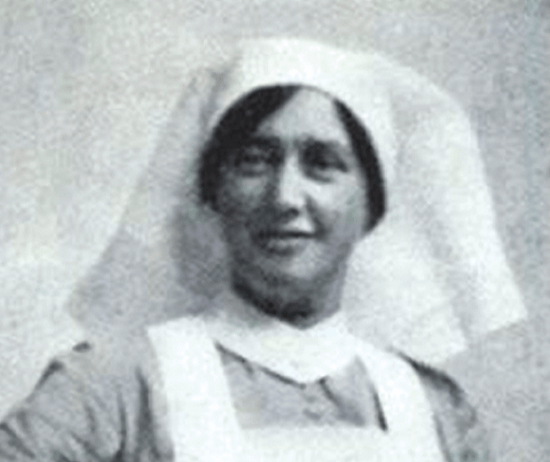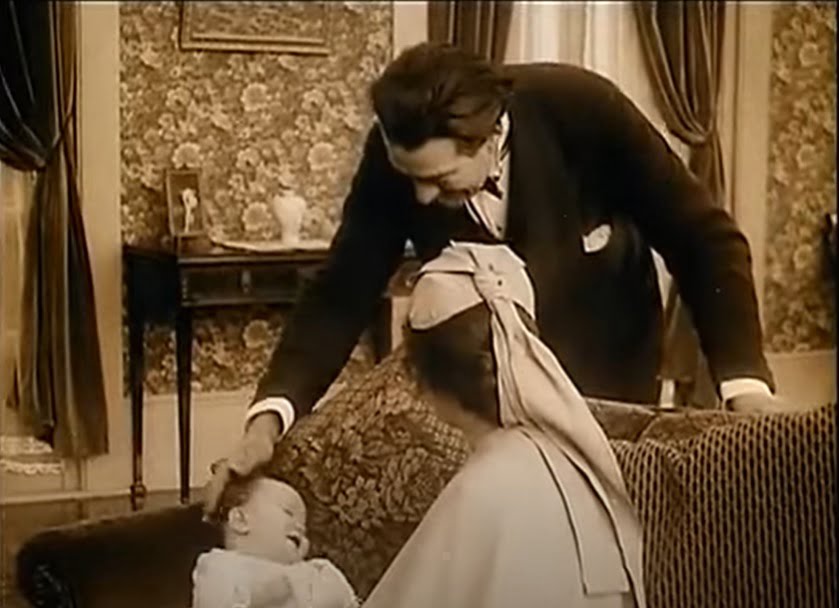An Irish nurse and member of Cumann na mBan, Elizabeth O’Farrell performed nursing and courier duties, delivering dispatches and ammunition to rebels over the days of the Easter Rising. She further risked her life to deliver Pádraig Pearse’s terms of surrender to the British forces on Friday, April 28, and stood with him when he surrendered to General Lowe later that day.
℘℘℘
It may have taken 100 years, but finally the hidden heroes of the Rising – the women who fought, those rebels shoved to the margins of history – were at last recognized during the centennial. Women played a major part during Easter week, but stories of their bravery became lost in the male-dominated theocracy that followed. Elizabeth O’Farrell was one such hero, a foot soldier turned footnote, remembered only for being forgotten, her pivotal role in the Rising airbrushed in a bit of early trick photography.
Born into a working-class Dublin family, Elizabeth was as a midwife at the National Maternity Hospital. She and her best friend, Julia Grenan, embraced the nationalist and feminist fervor of early 20th-century Dublin as suffragettes, fluent Irish speakers, members of Cumann na mBan (the women’s paramilitary organization), trained in weaponry and first aid by Countess Markievicz herself. They were also life partners whose sexuality remained as hidden as their bravery. “The love that dare not speak its name” had destroyed the life and reputation of fellow Dubliner, Oscar Wilde, who died in disgrace only 16 years earlier. Surely this resonated with Elizabeth, Julia and other lesbian soldiers most notably Dr. Kathleen Lynn; Madeleine ffrench-Mullen; the cross-dressing Maureen Skinnider, who was shot three times at the GPO; and the bisexual Abbey actress Helene Maloney.
Pádraig Pearse knew that he and his ragtag army of poets, socialists, and teachers were going to die, but knew too that it would be a “glorious failure.” He believed, and history proved him right, that a blood sacrifice and a set of instant martyrs were the key to Ireland’s freedom. Pearse and Connolly, both feminists, co-wrote the Proclamation of the Irish Republic which they, significantly, addressed to “Irishmen and Irishwomen.” The Proclamation gave women the right to vote, making it the first declaration of independence in history to promise equal suffrage. To further address women’s rights, Connolly ordered garrison commanders to allow female soldiers to fight. All agreed, save one: Éamon de Valera defied the order, claiming women were unfit for combat.
Easter Monday, April 24 to Easter Thursday, April 27
On Easter Monday morning, Elizabeth and Julia rushed to the epicenter of the action, the GPO, reporting to James Connolly and his assistant, Winifred Carney. They spent the week with medicine and ammunition hidden in their skirts, braving constant gunfire to run dispatches from the GPO to outpost battalions, managing, at the same time, to nurse wounded soldiers and civilians.
Easter Friday, April 28
On Friday, April 28, after constant bombardment, the GPO was on fire and about to collapse. Elizabeth, Julia, and Winifred were the only women left. Pearse wanted them to run for safety, but they refused, as did Winifred Carney, who was never to leave the side of the seriously-injured Connolly. The “glorious failure” was over; it was time for the Republicans to evacuate the GPO. To avoid the open streets, they were forced to “mousehole,” that is, blast through walls and adjacent rooms, until they arrived at a back room at No. 15 Moore Street. Once inside, the three women continued nursing as Pearse and Connolly discussed the logistics of surrender.
Easter Saturday, April 29
Easter Saturday, April 29, Pearse needed word of the cease-fire to reach the senior officer of the British Forces in Ireland, Brigadier General Lowe. He felt it would be safer for a woman to deliver the message, and charged Elizabeth with confronting Lowe and informing him of Pearse’s wish to “treat” (or negotiate). Thus empowered, Elizabeth grabbed a white flag and a Red Cross armband, and on Saturday at 12:45 p.m., prepared to leave Moore Street for Lowe’s headquarters at 70 Great Britain (now Parnell) Street. Watching her leave for the 250-meter journey, a wounded soldier assured her, “They would never fire on a woman.”
Theo Dorgan was commissioned by the Irish Centre to write verse for the centennial. Below, his poem, “We Carried It to Here as Best We Could,” goes inside Elizabeth’s head as she leaves her comrades:
Gathered all that I had been until now, my time on earth,
stood, smoothed my skirts, pinned up my hair. Pearse, by the stretcher,
sought my eyes: “Now, Liz, be of good heart. This is not defeat,
we’ve made a good beginning now, we’ve carried it to here.”
I bowed my head, I would not weep. The walls, the roof, crashed in.
“We’ve carried it to here” – words that stayed with her as she walked, seemingly oblivious (according to eyewitnesses) to the heavy gunfire around her. She reached the military barricade, stopped before General Lowe and spoke first, “The Commandant of the Irish Forces wishes to treat with the Commandant of the British Forces in Ireland.”
Lowe told her there would be “no treat,” only unconditional surrender and to give Pearse that message. After three round trips, each one with her life in danger, Elizabeth finally returned to Lowe, this time with Pearse. Before they left, Pearse said the rosary, brushed off his uniform and at 3:30 p.m., April 29, the President of Ireland and the nurse appeared before the Brigadier General. Pearse surrendered his sword, Elizabeth standing at his right side. A British army photographer captured the moment, the shot becoming one of the most iconic of the 1916 Rising.
Low Sunday, April 30
When the grainy photograph ran the next day in a London tabloid, the Daily Sketch, Elizabeth was present. But soon, she was absent, excised with almost surgical precision from an event she facilitated. Why? Sexism, always a likely culprit, may have come into play; a woman didn’t belong in such a historic moment. Pearse, a man who carefully curated his image, could have orchestrated the shot. Or, after his execution, Pearse’s followers could have altered the photograph, Miss O’Farrell being a distraction. General Lowe could have done the same thing, believing a woman cheapened the gravitas of the situation. In later years, Elizabeth claimed she deliberately stepped back since she was nothing if not a loyal soldier. In any event, she was airbrushed out of the picture and written out the event.
The surrender accomplished, Elizabeth had now an even more dangerous mission – take copies of the cease-fire order to the rebel commanders stationed throughout the city. She had to crisscross all of Dublin, dodging bullets, sidestepping dead bodies as she made the rounds of the garrisons.
Again, Theo Dorgan speaks for her:
Dead bodies in doorways, on the streets, this I remember,
the stench, quick swarming flies… and not just soldiers – volunteers,
yes, but ordinary men and women, and children too,
my god the children!
When she arrives at the garrison at Boland’s Mill, de Valera thought her a spy and her message a hoax until a male officer arrived to confirm her story.
Elizabeth had seen Julia and Winifred marched off to Kilmainhaim, but General Lowe had promised she wouldn’t be arrested. Nonetheless, she was strip-searched and tossed in a cell while the messages and funds soldiers had entrusted to her were confiscated. She was released later, and though maybe a less formidable woman would have been content with her freedom, not so with Elizabeth.“What about the money that was taken from me?” she demanded. “There was £16 taken out of my pocket and I want it back.” Lowe returned the money to her.
After the Rising, Elizabeth and Julia fought in both the War of Independence and the Civil War, remaining dedicated members of Cumann na mBan and ardent republicans for the rest of their lives. How painful it must have been for them to witness the nemesis of women’s rights, Éamon de Valera, rise to power. They experienced, up close and personal, his reactionary, sexist, and Church-centric policies dominate Ireland for 40 years. When Elizabeth O’Farrell died in 1957, she was buried in the Republican section of Glasnevin Cemetery. Her tombstone pays tribute to her treacherous walk through Dublin on Easter Saturday, with a piece of verse by Brian O’Higgins:
When duty called on the field of battle,
She went, under orders, the foe to meet,
Bearing sadly, unfearingly, proudly,
The flag of surrender but not defeat.
Julia Grenan died in 1972 and the two were reunited at Glaslevin. Julia was noted on stone as “faithful comrade and longtime friend.” This inscription inspired a poem written in 2016 by Jane Clark, another tribute that emerged from the centennial:
In Glasnevin
– For Elizabeth O’Farrell and Julia Grenan
Finding the words carved
on their plain, granite headstone,faithful comrade, lifelong friend,
reminds me of my grandmotherwho used to say, there was none of that
in my day. I wish I could askthe faithful Julia and Elizabeth
were they grateful for the mercyof sharing a grave, did they choose
those words to save them from shame,did they have someone to tell
that though the words said so much,they didn’t say enough, and when
they nursed the rebellion’s wounded,did they question the cost
of a new (free) state. ♦



